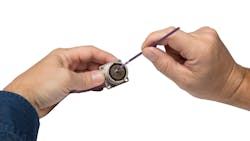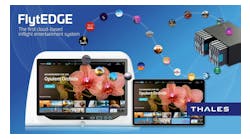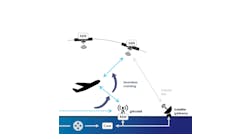Ensuring Fiber Optic Reliability Reaches New Heights
Fiber optics have become an integral part of the aviation industry. From communication systems, deck displays, and inflight entertainment used in commercial airliners; to flight planning, and sensor data fusion for weapon systems in military jets, it is central to all aircraft. Thanks to its capacity to transmit vast amounts of data at super-fast speeds, it can support the latest sophisticated technologies used in onboard applications.
In addition to the bandwidth advantage, it is also versatile, compact and lightweight. Unlike legacy copper wiring, fiber optics with its lighter material composition and smaller connectors meet the demand for reduced SWaP (size, weight, and power) consumption required by today's aerospace and defense applications. In fact, cabling weight can be reduced by more than 90% and carry high-speed data 15 to 20 times further, which is especially beneficial for airborne systems[1].
Fiber optics will continue to play a significant role in the future of avionics, therefore, maintaining its high performance is critical to its reliability. Without implementing cleaning procedures to guarantee optimal operation, uninterrupted connectivity and high-speed operation can be affected.
Sources of Contamination
Durable, fiber optic connectors are exposed to demanding conditions including, extreme temperatures, high humidity, harsh weather conditions and excessive shock and vibration. These factors make cleaning all the more important as any contaminant can affect connectivity.
Salt fog residue, hydraulic fluid, engine emissions, atmospheric dust and penetrating oils can cause connectivity failure. Although particulate can be as small as just 5 microns in size, contamination is the number one cause of fiber network failure. Removal is not just important but critical. Any contaminant left on the end-face can alter the signal path and change the refractive index causing signal degradation. Therefore, it is essential that proper fiber cleaning tools and methods are used during the installation or maintenance process to future-proof connection.
Wear debris is one of the most common sources of end-face contamination on an aircraft. The continuous vibration creates surface-to-surface wear between the individual components of a mating connector resulting in dust contamination. This creates an air-gap between end-faces resulting in back reflection, signal attenuation and instability. The particles can also be ground into the ferrule surface, resulting in pitted or scarred end-faces.
The connectors used on aircraft can make the contamination challenge even harder to resolve. For example, a common connector system used on military jets is the MIL 38999 connector and MIL 29504 termini. Used for cable to panel I/O interconnections, these connectors depend on spring-loaded termini to maintain physical contact when exposed to high vibration, impact, and shock motions. Unfortunately, the same strong contact force that holds mated termini together, also grinds dust particles into the ferrule surfaces resulting in scratched end-faces.
Compounding the problem further is electro-static charge. Static buildup on the ceramic and composite ferrule materials can have a huge effect on the performance of the fiber. Made with dielectric materials, the ferrules and glass fibers act as electrical insulators. This means the static charge has no place to go and can remain indefinitely on the end face and continually attract dust particles. The lower humidity levels experienced on an aircraft often increase the static charge further making it a significant problem if not addressed.
Clean Connectors
Clean connections help to guarantee optimal operation, uninterrupted connectivity and the high-speed operation of the fiber. However, due to the complex connectors designed to withstand extreme mechanical stress and the harsh environments, the task is not straightforward.
Connectors like the military’s MIL 38999 and ARINC 801 used within commercial aircraft can be complex to clean. With deep geometries and differing height, traditional fiber optic cleaning tools cannot be used. Disassembling the adapters and the connectors to clean the fiber end-faces would be time consuming and expensive. Therefore, it requires special tools and methods to clean them effectively.
High Standards
Cleaning and inspecting fiber optic connectors are key to its reliability. To ensure cleaning is done correctly, it is important to follow standards that guide technicians in determining fiber optic connector end-face quality and ensure no negative performance impact. One of the most common standards within the fiber optic industry is the International Electrotechnical Commission (IEC) 61300-3-35. It includes precise cleanliness grading criteria to measure pass or fail certification for the inspection of a fiber end-face before connection. In the aviation industry there are further standards to follow that define test methods and qualification of aerospace fiber optic components. These include the ASD STAN (Associated Body to European Committee for Standardization for Aerospace Standards) and ARINC (Aeronautical Radio INC), which specifies the dimension, performance and quality assurance criteria for fiber optic interconnect components and test procedures for fiber interconnect assemblies.
One of the best ways to meet these standards is to use fiber optic cleaning tools, fluids and methods engineered specifically for fiber optic cleaning applications. Better cleaning tools and procedures allow technicians to clean quickly and thoroughly.
Preparation is Key
When cleaning fiber, it is important to eliminate any contamination sources. If possible clean fiber within an enclosed space like the aircraft hangar. This will help reduce the airborne dust and debris that can come into contact with the fiber connectors.
The first step in cleaning the mated fiber connectors is to clean the outside of each connector with an aerosol-packaged duster and general cleaning wipes. Do not use duster products directly on the end-faces after disconnecting them. The movement of the duster gas creates static and draws dust and other contaminants to the end-faces like a magnet.
Clean the adapters and any inspection tools to prevent any cross-contamination. Once these initial steps are complete the fiber connectors can be cleaned.
Choose the Cleaning Fluid Carefully
When cleaning fiber end faces, it is important only to use fluids that have been engineered specifically for fiber cleaning. Avoid using aqueous (water-based) cleaning solutions or pure isopropyl alcohol (IPA). Aqueous products are slow to dry and can leave moisture on the end faces. If not completely removed before the fiber is connected in the sleeve, the laser-energized fiber can instantly vaporize the remaining liquid into a gas, causing an explosion through sudden expansion of the vapors.
As with water-based cleaners, IPA may explode or catch on fire when left on a highly energized fiber end face. IPA also frequently leaves a hazy film behind when it dries. Instead, use a fast-drying, high-purity fluid optical-grade fluid engineered specifically for cleaning fiber optics. It is also important to make sure the fluid is not hygroscopic so it does not absorb moisture and contamination from the air.
Optical Grade Wipes
An optical grade cleaning wipe is always the best choice when cleaning fiber as it does not lint or generate a static charge in use. Optical-grade wipes consist of soft material so as not to scratch the ceramic or composite ferrule end face. They are also highly absorbent for wiping the contamination away from the surface of the end face. It is important to ensure the wipes are in sealed packages to keep them pure and clean prior to use.
Do not oversaturate the wipe when wetting with cleaning fluid. Too much cleaning fluid on the fiber increases the chance that the fiber ends are re-contaminated as the fluid absorbs dust, engine fumes and other impurities from the air. Instead, choose a cleaning fluid in a package that delivers the cleaning fluid in metered doses. This controls the amount of cleaning fluid on the fiber and ensures the surfaces are dry after cleaning.
Always inspect the termini on both ends of a connector pair before cleaning to identify the level of contamination. Using the wet/dry cleaning method, dispense the static-dissipative cleaning fluid onto a section of the wipe. Next, starting at the damp area wipe the connector end-face moving in one direction towards the dry area of the wipe. This will remove any contamination and dissipates electro-static charge at the same time. When complete, inspect again to ensure all contaminant has been removed.
Clean Confidently with Cleaning Sticks
To clean termini in hardened connector housings commonly used on aircraft, it is recommended that a cleaning stick is used as they can successfully clean without the need to take apart the connector or adapter. By cleaning the entire end face and not just the contact zone they give the largest effective cleaning region on the terminus surface for eliminating issues associated with contaminates migrating into the signal path.
When using stick cleaners dampen first with cleaning fluid, insert into the connector and only rotate in the one direction; usually, 4 to 8 rotations is sufficient. Importantly, remember to only use one stick per end-face to avoid cross-contamination.
Use a non-linting cleaning stick that matches the configuration of the end-face. A well-engineered cleaning stick will also make incidental contact with the alignment sleeve sidewalls allowing fluid from the cleaning stick to contact the sidewalls and instantly defuse static charges so debris on the alignment sleeve does not jump onto the clean connector end-face during insertion.
Inspect your Work
After cleaning has taken place, inspect all the termini on both ends of a connector pair before mating. The inspection processes help visually identify problems like permanent defects, scratches and pitting, and any contamination that can interfere with or damage the surface of the optical termini. This guarantees that everything is contaminant-free and helps to ensure the system runs reliably and that all data transmits at optimal speed.
Cleaning is not just important; it is critical to the long-term reliability of the fiber optic connectors used for aircraft applications. Therefore, it is essential that it is done correctly by remembering three simple steps - inspect, clean and re-inspect. It is vital to inspect both ends of a connector pair just before mating. If a replacement connector or new jumpers and patch cords are required, inspect, clean and inspect again. New does not mean clean!
Ensuring Fiber Reliability
Fiber cleanliness is crucial for reliability and connectivity. To meet the demanding bandwidth required by an aircraft’s optical network, the correct tools and cleaning procedures must be put in place to guarantee a robust and reliable system performance.
It is recommended that technicians follow the technical manual precisely so that cables are properly cleaned and maintained. This helps ensure the fiber optic technology used on the aircraft operates as intended and without fault.
Work to standards like those specified by the IEC, ASD STAN, and ARINC. Implement a planned maintenance program, and, only use tools manufactured by experienced suppliers specializing in fiber optic cleaning. Fundamentally, follow the inspect, clean, inspect process for all fiber installations and maintenance.
[1] https://www.army-technology.com/sponsored/the-next-step-in-optical-interconnectivity-for-the-defense-industry/




